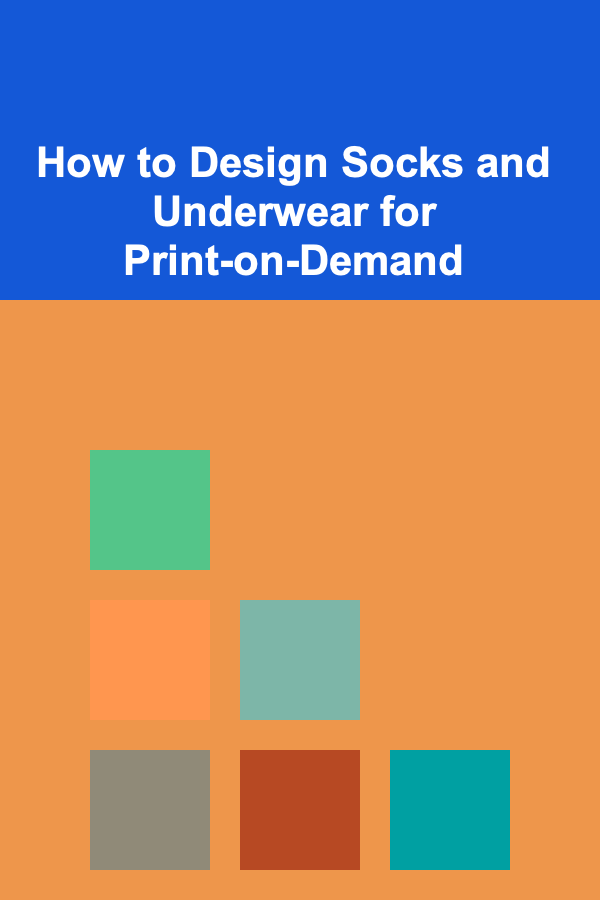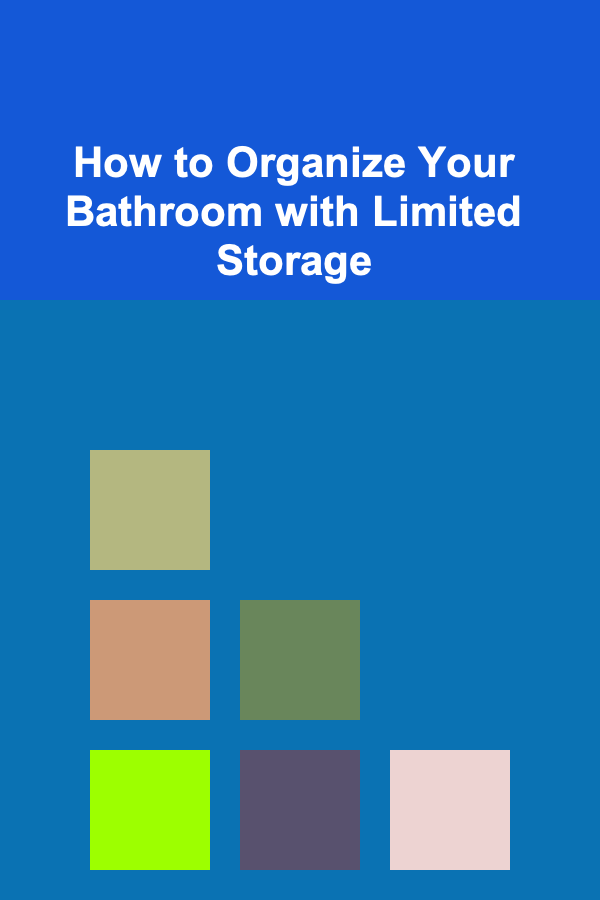
How to Design Socks and Underwear for Print-on-Demand
ebook include PDF & Audio bundle (Micro Guide)
$12.99$5.99
Limited Time Offer! Order within the next:

Designing socks and underwear for print-on-demand (POD) platforms can be both a creative and strategic endeavor. With the growing popularity of POD businesses, it's easier than ever for designers to bring their creations to life and sell them online without needing to invest in inventory or manufacturing. In this article, we will walk through the entire process of designing socks and underwear for print-on-demand, from conceptualization to final product design.
Understanding Print-on-Demand and Its Potential
Print-on-demand is a business model that allows entrepreneurs to sell custom products like clothing, accessories, and home decor without holding any physical inventory. The items are printed and shipped only when an order is placed, making it a low-risk venture for many designers and business owners.
This business model works on a process where designers upload their artwork, and a POD provider takes care of printing, packaging, and shipping directly to customers. This is particularly advantageous in the apparel industry, including products like socks and underwear, because it allows designers to focus solely on creating unique designs.
Designing socks and underwear for POD not only provides an opportunity to showcase creativity but also gives access to a potentially global market. The key lies in creating compelling designs that cater to diverse customer preferences and market trends.
The Process of Designing for POD
Designing for print-on-demand, especially for socks and underwear, involves several stages. These stages focus on understanding the product, crafting the right design, and ensuring that your creations are aligned with the POD platform's specifications.
Step 1: Understand the Product
Before diving into design, it's essential to understand the product's anatomy. The fit, style, and material of socks and underwear can vary widely, and this can impact how designs will look when printed.
Socks:
- Types of Socks: Consider whether you're designing crew socks, ankle socks, knee-highs, or no-show socks. Each type has different printing areas and construction that might affect how your design looks.
- Fabric: Most socks are made from a blend of cotton, polyester, and spandex, which means your design must be adaptable to stretchable materials.
- Print Areas: Socks typically have a small print area, usually around the ankle or midfoot. Design elements should be kept relatively simple or repetitive to ensure they look good when printed.
Underwear:
- Types of Underwear: There are various types of underwear, including boxers, briefs, thongs, and boxer briefs. Each type of underwear will have different print areas and stitching that must be considered.
- Material Considerations: Like socks, underwear is made from fabrics such as cotton, polyester, or elastane, which must be taken into account when choosing colors, textures, and patterns.
- Print Areas: For most underwear designs, the waistband, sides, and back provide the most printable space. The front panel is often less suitable for large designs, especially for men's underwear.
Step 2: Choosing Your Design Software
Once you understand the product, it's time to choose the right design software to bring your ideas to life. The choice of software is important because it impacts the quality of the designs and their compatibility with POD platforms.
Popular Design Software:
- Adobe Illustrator: Ideal for creating vector-based designs that can be scaled to any size without losing quality. Illustrator is one of the best tools for creating intricate and clean designs for socks and underwear.
- Photoshop: Great for bitmap-based designs like patterns and photo-realistic designs. While it's less scalable than Illustrator, it's an excellent choice for those working with textures, gradients, and more complex color schemes.
- Procreate: A favorite for digital artists, especially those using tablets. Procreate is perfect for hand-drawn designs, giving users an intuitive drawing experience.
- CorelDRAW: Another vector-based tool that is user-friendly and widely used in the fashion industry for design purposes.
Step 3: Design with Practicality in Mind
When designing socks and underwear for print-on-demand, it's important to think about the printing limitations of POD providers. Since these items are made from fabric and require printing techniques such as sublimation or direct-to-garment (DTG), there are a few practical considerations.
Consider the Design's Compatibility with Printing Methods:
- Sublimation Printing: This printing technique is perfect for socks and underwear, as it works well on polyester fabrics and allows for vibrant, all-over prints. Keep in mind that sublimation requires a white or light-colored base fabric for the best results.
- DTG Printing: Direct-to-garment printing is great for cotton fabrics and works well for intricate designs. However, it might not produce as vibrant colors on darker fabrics.
Design Tips:
- Simple Designs Work Best: Since socks and underwear have limited print areas, simpler designs often look cleaner and more appealing. Avoid overly complex graphics or images that may not translate well to small, tight spaces.
- Repetition: Repeating patterns or geometric designs work exceptionally well on these products. These designs can cover the entirety of the socks or underwear, creating a more seamless and professional look.
- Bold Colors: Bold, contrasting colors typically work best for socks and underwear. Consider using colors that stand out but don't overpower the design.
Step 4: File Preparation and Formatting
Once your design is ready, you must format it according to the specifications provided by the POD platform you intend to use. Every platform has specific file and dimension requirements, so it's essential to adhere to them for a successful print run.
Common Specifications:
- Resolution: A resolution of 300 DPI (dots per inch) is recommended for high-quality printing. Low-resolution files can result in pixelated prints.
- File Type: Most POD providers prefer PNG files with transparent backgrounds. This format ensures the design looks sharp and clean without any unwanted borders or backgrounds.
- Color Mode: Always use RGB color mode, as this is best suited for digital screens and print-on-demand processes.
Step 5: Test Your Designs
After you've uploaded your designs, it's a good idea to test them on mock-up templates provided by the POD platform. These templates simulate how your designs will look on actual products. By reviewing the mock-ups, you can make necessary adjustments before the products go live for sale.
Pro-Tip:
Consider ordering sample products for yourself. This allows you to assess the quality of the prints and the overall look of your design on real-life socks and underwear.
Best Practices for Marketing Your Designs
Once your socks and underwear designs are ready to be sold, the next step is to market them effectively. POD platforms usually provide various ways to promote your products, and marketing plays a crucial role in generating sales.
Utilize Social Media
Social media platforms like Instagram, Pinterest, and Facebook are ideal for showcasing your designs. Since socks and underwear are wearable items, they can be effectively promoted through lifestyle imagery and user-generated content.
- Influencer Partnerships: Reach out to influencers or bloggers in the fashion and lifestyle niches. They can help promote your designs and give them exposure to a broader audience.
- Hashtags: Use relevant hashtags like #socksdesign, #underwearfashion, or #customclothing to increase the discoverability of your products.
Build an Online Store
You can also set up your own e-commerce store on platforms like Shopify or Etsy, which integrate seamlessly with print-on-demand services. Customize your store to showcase your socks and underwear designs in a way that aligns with your brand.
Create Limited Edition Collections
Offering limited edition designs or seasonal collections can create a sense of urgency, encouraging customers to make a purchase. Exclusivity is a powerful tool in e-commerce, especially when it comes to fashion.
Staying Competitive in the Market
The POD market for socks and underwear can be highly competitive, with new designs popping up daily. To stay competitive, it's crucial to keep up with trends, monitor customer feedback, and continuously improve your designs.
Monitor Trends
Fashion trends evolve, and keeping track of these trends can help you stay relevant. Whether it's a specific pattern, color, or theme, designing with the current market in mind ensures that your products resonate with potential buyers.
Customer Feedback
Pay attention to customer reviews and feedback. If customers express a desire for particular designs, fabrics, or fit, this can guide your future creations. Engaging with customers also builds trust and loyalty.
Conclusion
Designing socks and underwear for print-on-demand platforms offers tremendous creative freedom and business potential. By understanding the product, choosing the right software, considering the printing methods, and marketing your designs effectively, you can turn your creative ideas into a successful online business.
Whether you're creating fun, quirky socks or stylish, comfortable underwear, the POD model gives you the opportunity to tap into a global market with minimal risk and investment. All it takes is a passion for design, an eye for trends, and a commitment to quality to build a successful brand in the POD fashion world.

How to Build Wealth Through Smart Financial Decisions
Read More
How to Craft Compelling Internal Monologue
Read More
How to Organize Your Bathroom with Limited Storage
Read More
How to Let ChatGPT Help You Understand Complex Concepts
Read More
How to Tailor Your Morning Routine Checklist to Your Chronotype
Read More
How to Make Vegan Cheese That Actually Tastes Like Cheese
Read MoreOther Products

How to Build Wealth Through Smart Financial Decisions
Read More
How to Craft Compelling Internal Monologue
Read More
How to Organize Your Bathroom with Limited Storage
Read More
How to Let ChatGPT Help You Understand Complex Concepts
Read More
How to Tailor Your Morning Routine Checklist to Your Chronotype
Read More